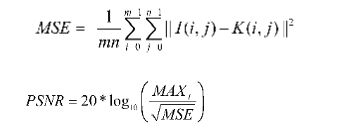Python计算Y通道或者RGB通道的PSNR_SSIM
Python计算Y通道或者RGB通道的PSNR_SSIM
-
- 一、 PSNR与SSIM简介
- 二、代码实现
- 三、运行、保存结果展示
一、 PSNR与SSIM简介
- 峰值信噪比(Peak Signal-to-noise Ratio, PSNR) 和结构相似性 (Structural Similarity, SSIM) 常作为图像超分辨重建任务主要的评价指标。
- PSNR度量图像压缩或信号重建图像与原始图像的像素差异,单位为dB,其值越大,则表明图像的失真度越小,计算公式如下:

公式中,MAXi 为图像最大像素值(RGB图像,像点颜色数值为255);MSE表示两幅尺寸为m×n图像I与图像K的均方误差值。 - SSIM是衡量两幅图像在噪声干扰、畸变或者失真时亮度(luminance)、对比度(constrast)以及结构的指标(structure),取值范围为[0,1],数值越接近1,失真程度越小。其公式如下:

二、代码实现
-
主要的代码源于 :
-
添加:PSNR/SSIM计算结果,保存文件(txt),便于后期导入excel列表分析。
-
代码介绍:PSNR_SSIM效果和matlab计算的结果一致(本人没有验证)。
-
代码功能,能够计算图像的Y_channel 或者RGB_channel状态下的PSNR_SSIM结果
-
用法:将真实图片,生成图片分别放入两个文件夹,代码中有选择两种方式(only_Y, RGB),切换注释相应的代码行即可。
-
注意:代码中涉及相应的代码库,如果没有,记得安装。
'''
calculate the PSNR and SSIM.
same as MATLAB's results
'''
import os
import math
import numpy as np
import cv2
import glob
import os
def main():
# Configurations
# GT - Ground-truth;
# Gen: Generated / Restored / Recovered images
folder_GT = '/content/drive/MyDrive/Experiment/codes/26_PSNR_SSIM/All/groud_truth_png'
folder_Gen = '/content/drive/MyDrive/Experiment/codes/26_PSNR_SSIM/All/1_ESPCN_png'
#save the psnr and ssim score by txt
PS_path = '/content/drive/MyDrive/Experiment/codes/26_PSNR_SSIM/Score'
if not os.path.exists(PS_path):
print('NO_path to sava the NIQE_Score,Making....')
os.makedirs(PS_path)
else:
print("The NIQE_Score_path has existed")
PS_txt = open(PS_path +'/score1.txt', 'a' )
crop_border = 4 # same with scale
suffix = '' # suffix for Gen images
test_Y = False # True: test Y channel only; False: test RGB channels
PSNR_all = []
SSIM_all = []
img_list = sorted(glob.glob(folder_GT + '/*'))
if test_Y:
print('Testing Y channel.')
else:
print('Testing RGB channels.')
for i, img_path in enumerate(img_list):
base_name = os.path.splitext(os.path.basename(img_path))[0]
print(base_name)
im_GT = cv2.imread(img_path) / 255.
#不同格式图像
# im_Gen = cv2.imread(os.path.join(folder_Gen, base_name + suffix + '.tif')) / 255.
im_Gen = cv2.imread(os.path.join(folder_Gen, base_name + suffix + '.png')) / 255.
if test_Y and im_GT.shape[2] == 3: # evaluate on Y channel in YCbCr color space
im_GT_in = bgr2ycbcr(im_GT)
im_Gen_in = bgr2ycbcr(im_Gen)
else:
im_GT_in = im_GT
im_Gen_in = im_Gen
# crop borders
if crop_border == 0:
cropped_GT = im_GT_in
cropped_Gen = im_Gen_in
else:
if im_GT_in.ndim == 3:
cropped_GT = im_GT_in[crop_border:-crop_border, crop_border:-crop_border, :]
cropped_Gen = im_Gen_in[crop_border:-crop_border, crop_border:-crop_border, :]
elif im_GT_in.ndim == 2:
cropped_GT = im_GT_in[crop_border:-crop_border, crop_border:-crop_border]
cropped_Gen = im_Gen_in[crop_border:-crop_border, crop_border:-crop_border]
else:
raise ValueError('Wrong image dimension: {}. Should be 2 or 3.'.format(im_GT_in.ndim))
#不同通道数(Y通道和RGB三个通道),需要更改
# calculate PSNR and SSIM
# PSNR = calculate_psnr(cropped_GT * 255, cropped_Gen * 255)
PSNR = calculate_rgb_psnr(cropped_GT * 255, cropped_Gen * 255)
SSIM = calculate_ssim(cropped_GT * 255, cropped_Gen * 255)
print('{:3d} - {:25}. \tPSNR: {:.4f} dB, \tSSIM: {:.4f}'.format(
i + 1, base_name, PSNR, SSIM))
PSNR_all.append(PSNR)
SSIM_all.append(SSIM)
single_info = '[{}],PSNR(dB),{:.4f}, SSIM,{:.4f}'
PS_txt.write(single_info.format(base_name,PSNR,SSIM))
PS_txt.write("\n")
Mean_format = 'Mean_PSNR: {:.4f}, Mean_SSIM: {:.4f}'
Mean_PSNR = sum(PSNR_all) / len(PSNR_all)
Mean_SSIM = sum(SSIM_all) / len(SSIM_all)
print(Mean_format.format(Mean_PSNR,Mean_SSIM))
PS_txt.write(Mean_format.format(Mean_PSNR,Mean_SSIM))
PS_txt.write('\n')
def calculate_psnr(img1, img2):
# img1 and img2 have range [0, 255]
img1 = img1.astype(np.float64)
img2 = img2.astype(np.float64)
mse = np.mean((img1 - img2)**2)
if mse == 0:
return float('inf')
return 20 * math.log10(255.0 / math.sqrt(mse))
def calculate_rgb_psnr(img1, img2):
"""calculate psnr among rgb channel, img1 and img2 have range [0, 255]
"""
n_channels = np.ndim(img1)
sum_psnr = 0
for i in range(n_channels):
this_psnr = calculate_psnr(img1[:,:,i], img2[:,:,i])
sum_psnr += this_psnr
return sum_psnr/n_channels
def ssim(img1, img2):
C1 = (0.01 * 255)**2
C2 = (0.03 * 255)**2
img1 = img1.astype(np.float64)
img2 = img2.astype(np.float64)
kernel = cv2.getGaussianKernel(11, 1.5)
window = np.outer(kernel, kernel.transpose())
mu1 = cv2.filter2D(img1, -1, window)[5:-5, 5:-5] # valid
mu2 = cv2.filter2D(img2, -1, window)[5:-5, 5:-5]
mu1_sq = mu1**2
mu2_sq = mu2**2
mu1_mu2 = mu1 * mu2
sigma1_sq = cv2.filter2D(img1**2, -1, window)[5:-5, 5:-5] - mu1_sq
sigma2_sq = cv2.filter2D(img2**2, -1, window)[5:-5, 5:-5] - mu2_sq
sigma12 = cv2.filter2D(img1 * img2, -1, window)[5:-5, 5:-5] - mu1_mu2
ssim_map = ((2 * mu1_mu2 + C1) * (2 * sigma12 + C2)) / ((mu1_sq + mu2_sq + C1) *
(sigma1_sq + sigma2_sq + C2))
return ssim_map.mean()
def calculate_ssim(img1, img2):
'''calculate SSIM
the same outputs as MATLAB's
img1, img2: [0, 255]
'''
if not img1.shape == img2.shape:
raise ValueError('Input images must have the same dimensions.')
if img1.ndim == 2:
return ssim(img1, img2)
elif img1.ndim == 3:
if img1.shape[2] == 3:
ssims = []
for i in range(img1.shape[2]):
ssims.append(ssim(img1[..., i], img2[..., i]))
return np.array(ssims).mean()
elif img1.shape[2] == 1:
return ssim(np.squeeze(img1), np.squeeze(img2))
else:
raise ValueError('Wrong input image dimensions.')
def bgr2ycbcr(img, only_y=True):
'''same as matlab rgb2ycbcr
only_y: only return Y channel
Input:
uint8, [0, 255]
float, [0, 1]
'''
in_img_type = img.dtype
img.astype(np.float32)
if in_img_type != np.uint8:
img *= 255.
# convert
if only_y:
rlt = np.dot(img, [24.966, 128.553, 65.481]) / 255.0 + 16.0
else:
rlt = np.matmul(img, [[24.966, 112.0, -18.214], [128.553, -74.203, -93.786],
[65.481, -37.797, 112.0]]) / 255.0 + [16, 128, 128]
if in_img_type == np.uint8:
rlt = rlt.round()
else:
rlt /= 255.
return rlt.astype(in_img_type)
if __name__ == '__main__':
main()
三、运行、保存结果展示
- 包括单张和平均的PSNR_SSIM结果
